Resistant Starches are everywhere. This may be the biggest new food trend you haven't heard about yet. This was news to me -- but it is not news. Real nutritionists like the Fanatic Cook are blogging about it. Nutrition websites around the world ( OldWays Pt, Australia's HealthyEatingClub) are promoting them.
But you might not notice them on food labels. Starches and carbohydrates that resist digestion have been classified as dietary fiber for several years. Some of them could appear as "wheat flour", "corn starch" or "modified food starch". Green bananas, canned baked beans and cold potato salad are just naturally chock full of resistant starch.
Sara Lee(TM) and Aunt Millie(TM) feature them in their breads to increase fiber and decrease calories while preserving the "white bread" texture their customers love. Yogurt makers like StonyField Farm are using them to thicken yogurt while improving calcium absorption. They are going into pretzels, snack bars, power bars, and meal-replacement drinks.
The health-food (functional food, nutraceutical) claims are astounding.
These carbohydrates lower blood glucose and insulin levels [1] (about as well as other dietary fibers), prompt your body to burn the fat you eat instead of storing it [1], improve the way you reacts to insulin [2], decrease cholesterol [3], increase absorption of calcium and other minerals [4], promote "good bacteria" in your gut [5, 6], nourish your colon [6], and protect you from colon cancer [7].
To top it all off, they improve the texture of many kinds of foods, help you feel more satisfied after a meal, and cause less flatulance than "old fashioned" insoluble fiber.
There is good scientific evidence to back up all of these claims. Sounds too good to be true, doesn't it?
1. Resistant starch consumption promotes lipid oxidation
2. Insulin-sensitizing effects of dietary resistant starch
3. Adzuki resistant starch lowered serum cholesterol... ; The influence of enzyme-resistant starch on cholesterol metabolism in rats fed on a conventional diet.
4. Oligofructose stimulates calcium absorption in adolescents
5. In Vitro Utilization of Amylopectin and High-Amylose Maize (Amylomaize) Starch Granules by Human Colonic Bacteria
6. Starches, Resistant Starches, the Gut Microflora and Human Health
7. Resistant Starch Attenuates Colonic DNA Damage Induced by Higher Dietary Protein in Rats
Tuesday, January 31, 2006
Resistant Starch -- New Food Trend
Posted by
Family Nutritionist
at
1/31/2006 09:07:00 PM
2
comments
![]()
![]()
Tuesday, January 24, 2006
Cold Potatoes are Better
 According to this document published by the Oldways Food Issues Think Tank, it sounds as if the glycemic index of a baked potato goes down when it cools. The document promotes increasing fiber in the diet with an emphasis on resistant starch (starch that resists digestion and passes through to the large intestine) and a product called Hi-Maize resistant starch. Resistant starch is a type of dietary fiber. This product is meant to increase the dietary fiber of baked goods without giving them that "heavy" "high-fiber" texture.
According to this document published by the Oldways Food Issues Think Tank, it sounds as if the glycemic index of a baked potato goes down when it cools. The document promotes increasing fiber in the diet with an emphasis on resistant starch (starch that resists digestion and passes through to the large intestine) and a product called Hi-Maize resistant starch. Resistant starch is a type of dietary fiber. This product is meant to increase the dietary fiber of baked goods without giving them that "heavy" "high-fiber" texture.
Posted by
Family Nutritionist
at
1/24/2006 11:52:00 AM
0
comments
![]()
![]()
Labels: fiber, nutrition, resistant starch
Review of "Eat, Drink, and be Healthy"
This 2002 review doesn't criticize much about the book. It does try to lay out the key points made by the authors.
Some of the most interesting:
- There doesn't seem to be any relationship between calcium intake and bone loss
- There are apparent relationships between high dairy consumption and increased risks of prostate and ovarian cancer
- Exercised muscle cells handle insulin and glucose very efficiently -- sedentary people don't handle high-glycemic-index foods well.
- Some "complex carbohydrate" foods, like potatoes, cause bigger blood-sugar and insulin spikes than an equal-calorie amount of pure sugar.
- High insulin can cause high triglycerides, and low "good" HDL cholesterol and lead to heart disease.
- Some low-fat diets don't include enough unsaturated fat. Unsaturated fat can protect against heart disease.
None of these facts are news. At least, they are not news in 2005. The implication is that the USDA's recommendations (as of 2001) ignored these facts or did not balance them properly against other facts. According to the Harvard School of Public Health website, the new edition includes new information available since 2001 and a critique of MyPyramid (probably similar to the critique I wrote about in my last post). Probably worth a read.
Posted by
Family Nutritionist
at
1/24/2006 10:32:00 AM
0
comments
![]()
![]()
Monday, January 23, 2006
A Different Look at the Food Pyramid
 The Harvard School of Public Health claims that the USDA has made some important mistakes with the new pyramid at MyPyramid.gov. The first one is that the graphic does not give anyone any clues about how they should be eating. I have to agree with this. I could hang that pyramid up in my kitchen, but I wouldn't expect it to teach the kids what to eat. It wouldn't help me remember how to plan my daily diet or anyone else's.
The Harvard School of Public Health claims that the USDA has made some important mistakes with the new pyramid at MyPyramid.gov. The first one is that the graphic does not give anyone any clues about how they should be eating. I have to agree with this. I could hang that pyramid up in my kitchen, but I wouldn't expect it to teach the kids what to eat. It wouldn't help me remember how to plan my daily diet or anyone else's.
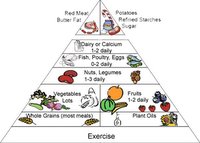 The Harvard researchers also say some of the USDA recommendations are off base. They suggest a pyramid full of words and pictures, showing which foods to eat most frequently. Their pyramid emphasizes eating less red meat, animal fat, "refined carbohydrates" and sugars. At the left is my attempt to represent their pyramid without copying their copyrighted graphic.
The Harvard researchers also say some of the USDA recommendations are off base. They suggest a pyramid full of words and pictures, showing which foods to eat most frequently. Their pyramid emphasizes eating less red meat, animal fat, "refined carbohydrates" and sugars. At the left is my attempt to represent their pyramid without copying their copyrighted graphic.They cite research showing that eating according to the "Harvard Healthy Eating Pyramid" guidelines is better for your health than eating according to the USDA guidelines.
Why? They say that, in addition to scientists and nutritionists, lobbyists "from a variety of food industries also helped shape the pyramid."
Food for Thought.
They recommend their book, Eat, Drink, and be Healthy and the healthy eating pyramids promoted by the Oldways Food Issues Think Tank.
Posted by
Family Nutritionist
at
1/23/2006 03:25:00 PM
0
comments
![]()
![]()
Portion Control
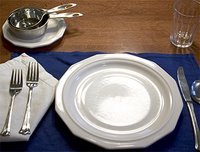 I bring measuring cups to the table. This makes portion control easier. Usually, one-cup and/or half-cup measures are all we need. Sometimes, we eyeball it. I also keep a quarter-cup scoop in the raisin box, to speed things up at breakfast. I'd put a scoop in the oatmeal box, too, but we don't all eat the same-sized portion.
I bring measuring cups to the table. This makes portion control easier. Usually, one-cup and/or half-cup measures are all we need. Sometimes, we eyeball it. I also keep a quarter-cup scoop in the raisin box, to speed things up at breakfast. I'd put a scoop in the oatmeal box, too, but we don't all eat the same-sized portion.
portion control
Posted by
Family Nutritionist
at
1/23/2006 08:33:00 AM
0
comments
![]()
![]()
Friday, January 20, 2006
How many servings in a cup of flour?
I was having a hard time finding all the information I need about serving sizes. MyPyramid.gov doesn't have all the information I want to figure out things like: If I make a loaf of bread out of 4 1/3 cups of flour, how many servings of grain are in that loaf?
So I created a login at mypryamidtracker.gov. I went to "food intake", entered 1 cup of unbleached enriched white bread flour, and clicked on "Calculate MyPyramid Stats". It told me I had just eaten 8.6 ounce equivalents of grain. The USDA Nutrient Database tells me that this same cup weighs 4.9 ounces. The USDA serving size for grains is based on a 1 oz slice of bread, which apparantly contains .57 oz of flour (assuming enriched unbleached white bread flour).
Similarly 1 oz of raw "regular" rolled oats gives 1.5 servings of grain and a cup of oats weighs 81 grams. I have to go to 2 different USDA sites to get this information, but once I have it I can reuse it.
Here's where I find USDA and DASH serving sizes for everything:
- DASH
- Grains (USDA)
- Vegetables (USDA)
- Fruits (USDA)
- Dairy (USDA)
- Meat and Beans (USDA)
- Fats (USDA)
- Added Calories (USDA)
- MyPyramidTracker dietary assessment
portion control DASH USDA
Posted by
Family Nutritionist
at
1/20/2006 09:15:00 AM
0
comments
![]()
![]()
Thursday, January 19, 2006
Better Carbs in the New Year
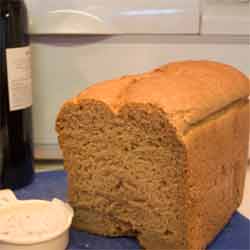 Actually, this isn't much of a New Year's resolution. I've been eating better bread for two years. I've hardly bought a loaf in that time.
Actually, this isn't much of a New Year's resolution. I've been eating better bread for two years. I've hardly bought a loaf in that time.
Except for the occasional loaf from an artisanal baker at a farmer's market, or from Sarcone's in Philadelphia. I cannot understand how they can sell such great bread so cheaply. If I lived closer to the store, I might never make my own. They inspired me to start making better bread. Their secret is no secret -- a long rise.
But I'm lazy. I use a bread machine. So one evening, when I was nearly out of yeast, I came up with a clever plan:
- Use maybe a quarter of the yeast you would normally use
- Run the machine through the dough cycle
- Reset the bread machine for a normal baking cycle, and set the delay timer so it will finish 8 hours later. Don't forget to start the machine again. I get this wrong about once a month.
- Wake up to the smell of freshly baked bread.
The long rise makes for a much better texture. Now you can really enjoy your whole wheat bread. Here's one that uses 69% whole wheat flour -- something I didn't dare try using a "normal" rise time. Unless I wanted to encourage everyone to switch from sandwiches to leftovers for lunch. We love this bread. And if whole wheat bread flour were easier to find, I'd switch to 100% whole wheat.
-= Exported from BigOven =-Overnight Light Whole Wheat Bread
The overnight rise guarantees a light texture for this 69% whole wheat bread. Using a bread machine with a timer, you can have a good nights sleep and freshly baked bread for breakfast.
Recipe By: Family Nutritionist
Serving Size: 22
Cuisine: American
Main Ingredient: Bread
Categories: Vegetarian, Meatless, Low Fat, Bake, Whole Grain, LOW SODIUM, DASH, Bread Machin, Bread
-= Ingredients =-
1 5/8 cups Water
1 1/2 tablespoon Canola oil
1 1/2 tablespoons Honey
1 teaspoon Salt
3 cups Whole wheat flour
1 1/3 cup White Bread Flour
1/4 cup Buttermilk powder
1/2 teaspoon Yeast
-= Instructions =-
If making bread by hand, use your favorite method for mixing ingredients. You may omit the oil.
Knead the dough and allow to rise for 4 or 5 hours or overnight.
Punch down; let rise until doubled. Form into loaf (on cornmeal-sprinkled bread peel or in loaf pan) and allow to rise for 30-45 minutes. Bake as usual for a 2 1/4 pound loaf.
If using a bread machine, add ingredients in the order recommended by the manufacturer.
Set the machine for the quickest dough setting. You may cancel the dough cycle as soon as kneading is over, or allow the dough cycle to complete. Set the timer so the bread will be ready when you want it, at least 6 hours later. If you start the dough an hour before you retire for the evening, then start the timed regular bread cycle just before you go, you can make sure that the bread is ready for you first thing in the morning. Be sure to have a good bread knife!
Yield: one loaf, approximately 2 1/4 pounds.
Nutritional information is based on baking this 2 1/4 pound loaf in an 11-inch bread pan and cutting 22 half-inch slices.
Nutritional Information
Servings: 22: Serving Size: half-inch slice (46 g): Calories: 104: Fat(g): 1: Sodium (g): 116
Food Group Serving(s)
DASH: Vegetables: 0.0: Fruits/Juices: 0.0: Dairy: 0.0: Grains: 1.5: Meat/Fish: 0.0: Seeds: 0.0: Fats: 0.2: Sweets: 0.2
USDA: Vegetables: 0.0: Fruits/Juices: 0.0: Dairy: 0.0: Grains: 1.5: Meat/Fish/Seeds: 0.0: Fats: 0.2: Sweets: 0.2
** This recipe can be pasted into BigOven without retyping. BigOven.com ID= 160436 **
** Easy recipe software. Try it free at: http://www.bigoven.com **
whole wheat bread DASH low sodium low fat
Posted by
Family Nutritionist
at
1/19/2006 11:46:00 AM
0
comments
![]()
![]()
You CAN put 2 cups of vegetables in a 1 cup bag
Or glass, with room to spare. If you liquify them. That's my conclusion, after asking Pete Romfh.
I have to confess that I haven't tried it yet. Pete just took such a great photograph I feel like it must taste as good as it looks. I hope I'm right!
Read all of "You CAN put 2 cups of vegetables in a 1 cup bag" ...
Posted by
Family Nutritionist
at
1/19/2006 11:42:00 AM
0
comments
![]()
![]()
Wednesday, January 18, 2006
I don't like low-carb bread
And I am not going to eat it.
Andrea Winchester wrote in Rookie Cookery that she is curbing the carbs and craving them. She even made a home video about throwing away the high-carb foods in her house. Actually, I wasn't sure what she was tossing and what she was keeping and why.
It's my understanding that a slice of fresh-baked whole-wheat (even 50% whole wheat) bread is good for you. So is a plate of pasta or a serving of rice (1/2 cup of pasta = 1/2 cup rice = 1 slice of bread, approximately). I like brown rice, but I don't like whole-wheat pasta, unless I make it myself. I do like the new Barilla PLUS pasta.
So why are people starting the new year by cutting out carbs?
low carb
Posted by
Family Nutritionist
at
1/18/2006 10:53:00 AM
0
comments
![]()
![]()
How big is your head?
 I just had a look at a zero-point soup in the BigOven archives -- see it at the bottom of this post. I calculated USDA and DASH serving sizes. I came to the conclusion that every 6.4 fl oz serving of this soup contains 1.8 cups (that's 14.4 fl oz) of vegetables. That's a little surprising, especially since the soup is not cooked -- none of the water in the vegetables is driven off.
I just had a look at a zero-point soup in the BigOven archives -- see it at the bottom of this post. I calculated USDA and DASH serving sizes. I came to the conclusion that every 6.4 fl oz serving of this soup contains 1.8 cups (that's 14.4 fl oz) of vegetables. That's a little surprising, especially since the soup is not cooked -- none of the water in the vegetables is driven off.
I understand that vegetables take up space when you liquify them in the food processor, but 48 fl oz of those vegetables were already in liquid form (V8 juice).
The next biggest contributor was the cabbage -- half a head. According to the USDA, a head of cabbage is 904 grams, and a cup of chopped cabbage is 70 grams. So half a head of cabbage gives us nearly 13 cups of chopped cabbage. That's almost 2/3 of a cup of cabbage in every 3/4 cup serving! According to my calculations, every serving (6.4 fl oz) contains:
0.6 cup Vegetable juice cocktailI've asked Pete Romfh (the author) what size his head is. Stay tuned.
0.64 cup Cabbage
0.4 cup Celery
0.025 cup Lemon juice
0.025 cup Worcestershire sauce
0.006 cup Tabasco sauce
0.1 cup Broccoli
0.05 cup Onion
-= Exported from BigOven =-
LoCal "Zero Points" Diet Soup
Low in calories amd fat, high in fiber and flavor; this dish is great when you are dieting. It can be served hot as a soup or cold like gazpacho.
Recipe By:
Serving Size: 10
Cuisine: American
Main Ingredient: Tomato Juice
Categories: Brunch, Snacks, Soup, Simple - Easy, No Cook, Low Fat, Low Carb, Vegetarian, Atkins-Friendly, Diabetic
-= Ingredients =-
48 ounces Vegetable juice cocktail ; Like V8, 1 large can
1/2 head Cabbage, green ; coarse chopped
4 cups Celery ; coarse chopped
1/4 cup Lemon juice ; - to taste
1/4 cup Worcestershire sauce ; - to taste
1 tablespoon Tabasco sauce ; - to taste
1 cup Broccoli ; - stems are fine
1/2 cup Onion ; -chopped
-= Instructions =-
This is a basic guide. You might think of this as "clean the vegetable tray" soup.
Cut up the vegetables and buzz them in the food processor until they are fairly fine. Gradually blend in the vegetable juice cocktail (I usually buy the "house brand") and seasonings. Taste as you go along until you get a nice tangy-spicy flavor.
Rmember that cold foods don't taste as strong as when they are warm so you may want to "under shoot" at first. You can always add more later.
This will make about 1/2 gallon (64 oz) of "soup". Store it in the refrigerator or freeze it in 6 oz containers to be thawed out later.
If you are watching salt intake use the Low Sodium version of vegetable juice.
Food Group Serving(s)
DASH: Vegetables: 3.2: Fruits/Juices: 0.0: Dairy: 0.0: Grains: 0.0: Meat/Fish: 0.0: Seeds: 0.0: Fats: 0.0: Sweets: 0.0
USDA: Vegetables: 1.8: Fruits/Juices: 0.0: Dairy: 0.0: Grains: 0.0: Meat/Fish/Seeds: 0.0: Fats: 0.0: Sweets: 0.0
Nutritional Information
As given, using original V8 juice:
Servings: 10: Serving Size: 6.4 oz: Calories: 55: Fat(g): 0: Sodium (g): 574
Using Low Sodium V8® 100% Vegetable Juice:
Servings: 10: Serving Size: 6.4 oz: Calories: 55: Fat(g): 0: Sodium (g): 181
** This recipe can be pasted into BigOven without retyping. BigOven.com ID= 159866 **
** Easy recipe software. Try it free at: http://www.bigoven.com **
DASH BigOven soup low sodium low fat
Posted by
Family Nutritionist
at
1/18/2006 08:33:00 AM
0
comments
![]()
![]()
Tuesday, January 17, 2006
Ziti reform
Here's where my EXCEL spreadsheet is worth the effort.
- A can of tomato sauce is only 14.5 ounces
- That could be too much pasta for 14.5 ounces of sauce
- And too much ricotta. A pound should feed 10 people.
 I quickly cut the pasta to 5 ounces, ricotta to 7.5 ounces, and mozzarella to 1/3 pound. Now I have exactly 1 grain and 1 dairy. Perfect! On to the vegetables. I like main-dish casseroles to have at least 2 vegetables per serving. I like mushrooms. The USDA list says 1 cup of chopped mushrooms weighs 70g. That's 2.5 ounces. So 5 ounces of mushrooms is 4 servings, or .8 serving per person. Add that to the 1.2 servings I had from onions, green pepper, and garlic, and I get 2 servings of vegetable per person. There's my new recipe.
I quickly cut the pasta to 5 ounces, ricotta to 7.5 ounces, and mozzarella to 1/3 pound. Now I have exactly 1 grain and 1 dairy. Perfect! On to the vegetables. I like main-dish casseroles to have at least 2 vegetables per serving. I like mushrooms. The USDA list says 1 cup of chopped mushrooms weighs 70g. That's 2.5 ounces. So 5 ounces of mushrooms is 4 servings, or .8 serving per person. Add that to the 1.2 servings I had from onions, green pepper, and garlic, and I get 2 servings of vegetable per person. There's my new recipe.
I'll have no trouble using up half a basket of mushrooms or the odds and ends of the other vegetables, but I will have to get a little creative to come up with a good use for the half-tub of ricotta.
Here's my recipe. It is also available from the BigOven archives.
-= Exported from BigOven =-
Baked Ziti with ground turkey for 5
http://www.bigoven.com/recipe160397
Recipe By: Family Nutritionist
Serving Size: 5
Cuisine: Italian
Main Ingredient: Pasta
Categories: Low Fat, Kid Friendly, Bake, LOW SODIUM, DASH, Pasta, Main Dish
-= Ingredients =-
15 ounces lean ground turkey
1/4 teaspoon fennel seed
5 ounces ziti pasta
7 1/2 ounces ricotta cheese, part skim milk
1/3 pound shredded lowfat mozzarella cheese
~~ Sauce ~~
4 cloves garlic ; minced
1/2 cup onion ; chopped
14 1/2 ounces low-sodium crushed tomatoes ; chopped (1 15-oz can low-sodium tomatoes)
1/2 cup green bell pepper
5 ounces button mushrooms
1/4 teaspoon dried rosemary
1/2 teaspoon dried oregano
-= Instructions =-
Mix ground turkey with fennel seeds. Brown turkey in large saucepan. Remove from pan.
Spray saucepan with cooking spray or brush with small amount of olive oil. Saute onions, garlic, and peppers, stirring occasionally, until soft, about 2 minutes. Add the remaining sauce ingredients. Raise heat to a boil, then lower to simmer for 45 minutes (or however long you''ve got!)
Preheat oven to 350F.
Cook ziti in boiling water until tender, according to package directions.
Reserve 1/2 cup of mozzarella cheese. Mix browned meat with ricotta and remaining mozzarella.
Ladle 1/3 of sauce in bottom of pan. Add 1/2 of pasta. Spread 1/2 of cheese mixture. Layer again with 1/3 of sauce, 1/2 of pasta, 1/2 of cheese mixture. Use a spoon to remove trapped air and get a little bit of mixing in the layers. Add the final 1/3 of sauce to the top. Top with the reserved mozzarella cheese.
Bake for about 1 hour, or until the sauce is bubbling and the cheese is melted.
If necessary, reheat at 350°F until hot through.
Nutritional Information
Servings: 5: Serving Size: 1/5 of pan (333 g): Calories: 410: Fat(g): 18: Sodium (g): 284
Food Group Serving(s)
DASH: Vegetables: 2.0: Fruits/Juices: 0.0: Dairy: 1.0: Grains: 1.0: Meat/Fish: 1.0: Seeds: 0.0: Fats: 0.0: Sweets: 0.0
USDA: Vegetables: 1.0: Fruits/Juices: 0.0: Dairy: 1.0: Grains: 1.0: Meat/Fish/Seeds: 3.0: Fats: 0.0: Sweets: 0.0
** This recipe can be pasted into BigOven without retyping. BigOven.com ID= 160397 **
** Easy recipe software. Try it free at: http://www.bigoven.com **
DASH portion control low sodium low fat
Posted by
Family Nutritionist
at
1/17/2006 01:30:00 PM
0
comments
![]()
![]()
Exchanges made easy.
My old cookbook is scanned and printed out. I punched holes in it and bound it in a 3-hole report cover -- the kind with brads. It isn't very thick. My book won't fall apart quite so quickly.
Next project: figure out the DASH "exchanges" for some family favorite recipes. I used to try to do these in MasterCook, but I could never really depend on the exchanges in MasterCook. Many ingredients have no exchange information. Pasta is always wrong, and who knows what else? Besides, MasterCook uses American Diabetic Association exchanges, which are different from DASH or USDA exchanges. So I am going to try doing it by hand for now, using EXCEL. I will start with an easy one: Baked Ziti.
So I am going to try doing it by hand for now, using EXCEL. I will start with an easy one: Baked Ziti.
Baked Ziti with ground turkey for 5
15 ounces lean ground turkey
1/4 teaspoon fennel seed
8 ounces ziti pasta
7 1/2 ounces ricotta cheese, part skim milk
1/3 pound shredded lowfat mozzarella cheese
4 cloves garlic minced
1/2 cup onion chopped
15 ounces low-sodium crushed tomatoes (1 can, no salt added)
1/2 cup green bell pepper
1/4 teaspoon dried rosemary
1/2 teaspoon dried oregano
Tomatoes, onion, and green pepper, and garlic are vegetables. A DASH serving of vegetables is 1/2 cup, which is 8 fl oz. That's 1.2 veg per serving.
And so on. The herbs (vegetables) and spices (seeds) don't add much
The result is:
DASH: Vegetables: 1.2: Fruits/Juices: 0.0: Dairy: 2.1: Grains: 1.6: Meat/Fish: 1.0: Seeds: 0.0: Fats: 0.0: Sweets: 0.0
I don't want to have to try to keep track of these fractions of servings for everyone in the family! So I am going to have to make some changes.
I got my exchange information from
- http://www.nhlbi.nih.gov/health/public/heart/hbp/dash/new_dash.pdf (pages 14-15)
- http://www.nhlbi.nih.gov/hbp/prevent/h_eating/h_e_dash.htm
- http://www.mypyramid.gov/pyramid/index.html
- The DASH diet book
Dinner pasta turkey tomatoes cheese portion control
Posted by
Family Nutritionist
at
1/17/2006 11:36:00 AM
0
comments
![]()
![]()
Maybe a New Printer Would Help!
After all that scanning, I couldn't print. Printer memory errors. Turns out my old HP 5MP laserjet has only 3 Meg of memory installed. Switching to a different printer driver (HP printer language instead of postscript) seems to have helped. It's a wonder I haven't printing problems before.
With BigOven, I have been copying the formatted recipes into Word. Then, I can force the ingredients into two columns, put page breaks where I want them, and do two-sided printing with odd/even margins. The folks at BigOven say they are working on making this easier in upcoming versions. It seems they are working on version 2 right now.
Posted by
Family Nutritionist
at
1/17/2006 11:27:00 AM
0
comments
![]()
![]()
Friday, January 13, 2006
Blackened Beef with Greens and Red Potatoes
This recipe originally comes from http://www.nhlbi.nih.gov/health/public/heart/other/syah/.![]() (version 1.8.962)
(version 1.8.962)
-= Exported from BigOven =-
Blackened Beef with Greens and Red Potatoes
A filling, warming, one-pot meal, served with bread. Don't skimp on the seasoning, and pass the Tabasco! Find it at http://www.nhlbi.nih.gov/health/public/heart/other/syah/
Recipe By: Stay Young at Heart: http://www.nhlbi.nih.gov/
Serving Size: 6
Cuisine: American
Main Ingredient: Beef
Categories: Low Fat, DASH, LOW SODIUM, Main Dish, Winter, Fall
-= Ingredients =-
1 pound lean top round of beef
2 tablespoons paprika
1 tablespoon dried oregano
1 teaspoon chili powder
1 teaspoon garlic powder
1/2 teaspoon freshly ground black pepper
1/4 teaspoon cayenne pepper
1/4 teaspoon dry mustard
6 medium red potatoes ; cut into quarters about 1 inch thick (about 6 cups)
3 cups finely chopped onions
2 cups beef broth
2 cups water
2 cloves garlic ; minced
3 large carrots ; cut into rounds about 1/4 inch thick
1 bunch kale ; stems removed, coarsely torn into piece
-= Instructions =-
Briefly put the beef in the freezer to freeze partially in preparation for slicing thinly.
Mix the paprika, oregano, chili powder, garlic powder, black pepper, cayenne pepper, and dry mustard in a small container with a lid and set aside.
Thinly slice the beefacross the grain into strips 1/8 inch thick. Sprinkle the strips liberally with the seasoning mix. (Save any leftover seasoning mix to use for other dishes.) Spray the bottom of a large skillet or stockpot with cooking spray and preheat over high heat. Add the meat and cook, stirring, for 5 minutes.
Add the potatoes, onions, broth, water, and garlic to the skillet. The blackened spices will float to the top of the liquid as it heats. Cover and cook over medium heat for 20 minutes. Stir in the carrots and lay the kale on top. Cook, covered, until the carrots are tender, about 10 more mm- utes. Serve from the skillet or transfer to a large serving bowl. Serve with crusty bread for dunking.
** This recipe can be pasted into BigOven without retyping. **
** Easy recipe software. Try it free at: http://www.bigoven.com **
-= Notes =-
Servings 6
Serving Size 2 cups
Calories per serving 278
Fat (g) 6
Sodium (mg) 106
DASH Food Group Serving(s):
Vegetables 4
Fruits/Juices 0
Dairy Foods 0
Grains 0
Meat, Poultry, and Fish 1
Nuts, Seeds, and Legumes 0
Added Fats/Oils 0
Sweets 0
Dinner beef potatoes DASH low fat low sodium
Read all of "Blackened Beef with Greens and Red Potatoes" ...
Posted by
Family Nutritionist
at
1/13/2006 09:44:00 AM
0
comments
![]()
![]()
Wednesday, January 11, 2006
EXCEL is the answer
What was the question?
BigOven can't deal with the ingredients list being separated by a block of instructions and notes. And it is hard to read the nutritional notes the way they are. How did something horizontal wind up vertical?
Since I just happened to know that EXCEL can handle this sort of thing, I decide to let it do the work.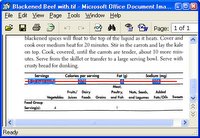
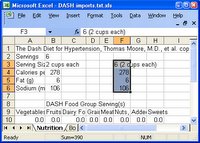

Select information Paste it into EXCEL Type in the serving info
After that, flip to the next worksheet,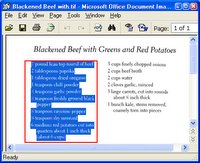
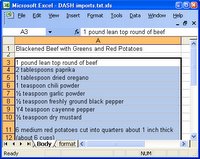
Paste in the title and the first column of ingredients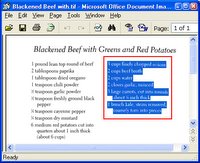
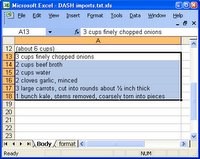
Paste in the second column of ingredients (and then the instructions)
Then I had to fix up some OCR errors (I taught EXCEL to fix some of them automatically)
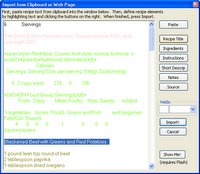
I created a third spreadsheet to pull the information out of the first two, ready to be imported into BigOven. I had it reformat the nutritional information with a little HTML so it will be be easier to read when it gets printed out.
I finished up the import by selecting sections of text and clicking buttons to show which part of the recipe they belonged in. I hit the import key, and there it was in BigOven
Now I have one recipe imported into my cookbook. The rest should go like clockwork!
DASH cookbook OCR EXCEL
Posted by
Family Nutritionist
at
1/11/2006 02:11:00 PM
0
comments
![]()
![]()
Monday, January 09, 2006
Import This
 I tried a lot of scanner settings, trying to get the OCR software to read everything. I finally settled on 600 dpi, with the darkness turned down quite a bit.
I tried a lot of scanner settings, trying to get the OCR software to read everything. I finally settled on 600 dpi, with the darkness turned down quite a bit.
I am using Microsoft Office Document Imaging 2003 (version 11). Amazingly, on this page, it got all of the fractions right. It even figured out that there are two columns of ingredients. But it made a mess of the tables at the bottom and put the second column of ingredients at the end of the recipe.
Import This!
DASH cookbook OCR
Posted by
Family Nutritionist
at
1/09/2006 08:07:00 AM
0
comments
![]()
![]()
Sunday, January 08, 2006
First There's the Cookbook

I have this cookbook that's falling apart. Actually, it is the recipe section from the DASH diet book. I decided to scan all the recipes and import them into BigOven. Then I'll print out a new cookbook from the scanned recipes.
Why not just print a copy of the recipes and be done? Because I like the idea of getting the computer to help me create a weekly meal plan by just dragging the recipes onto a calendar. Then I can print out a shopping list and a meal list, post the meal list in the kitchen, take the shopping list to the grocery store, and never be short 2 cups of broccoli at the end of the week again. In theory.
DASH cookbook BigOven
Posted by
Family Nutritionist
at
1/08/2006 08:51:00 AM
0
comments
![]()
![]()
Labels: DASH diet
Friday, January 06, 2006
Adventures of a Family Nutritionist
I have become the nutritionist for my family. And I am am trying to convert old recipes and develop new ones that conform to the DASH diet guidelines, and work out the DASH "exchanges" or "Food Group Servings" for the recipes.
I am using Recipe Management software you can get off the shelf. I have used Mastercook, and I have been working with BigOven lately.
I'll be posting here about my experiences getting recipes INTO my recipe databases, getting them OUT again (printing or sharing electronically), and working with recipes once I have them in the database. If all goes well, you'll see some my recipes posted here.
Posted by
Family Nutritionist
at
1/06/2006 08:34:00 PM
0
comments
![]()
![]()



